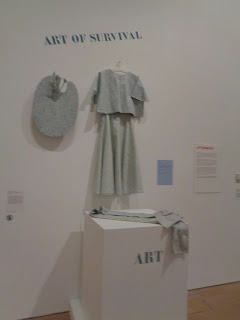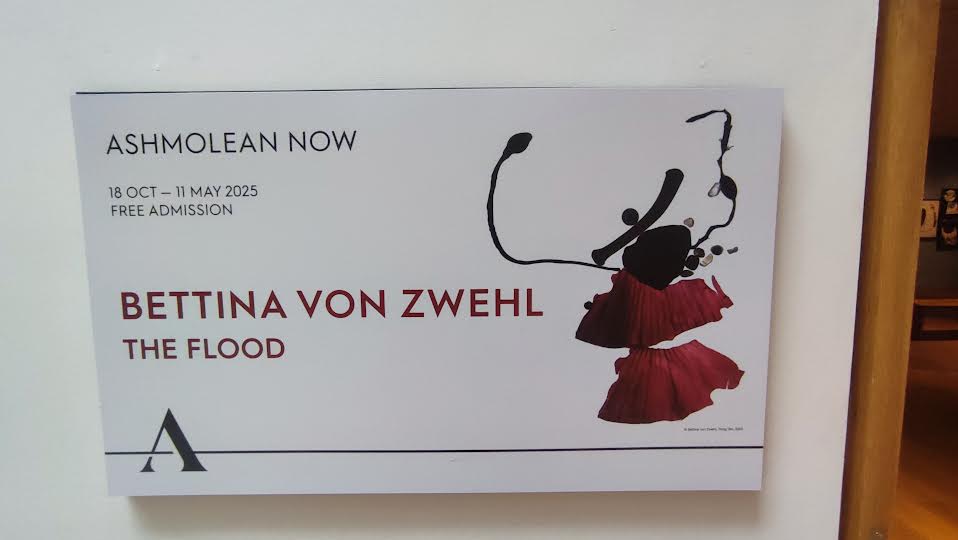The Whitworth - Women in Revolt! - Review
★ ★ ★ ★ ☆
After touring London and Edinburgh since 2023, Women in Revolt! – curated by Lindsey Young - arrives in Manchester at the Whitworth. This is the first time the exhibition has been free of charge.
Originally I had planned to visit Women in Revolt! with a
friend, but the plans fell through, so here I am, camera in hand, back in the
Whitworth. Living so close to the venue, I walk through Whitworth Park – it is
a beautiful day – and take the back entrance into the gallery. I only mention
this because one of the first things I encounter is a slice of text informing
me that this is room 5 of 7, and that I should instead start from the entrance
in the Special Collection’s Gallery. So, rather than interrupt the pre-determined
flow, I track round and begin the exhibition again.
By indicating a correct path, the gallery signals that this
is – counter to my expectations – a social history exhibition through the lens
of artists and their artworks. And this is indeed the case. Women in Revolt! is
very clear to signpost that it is arranged chronologically. One of the stated
purposes is to “remind us there is no single experience of being a woman, an
artist or an activist”. As such, instead of highlighting the work of some big
names, there are over 90 artist displayed over the 7 rooms.
The first room serves as an introduction. Taking its
starting point as the National Women’s Liberation Conference in 1970, there are
historical records – photographs, zines – relating to this in a central rectangular
cabinet. Text on the walls highlights a programme of talks, tours, and
screenings to go alongside the exhibition, as well as a content guidance pamphlet
– warnings of sensitive topics, and indicating the gallery staff as approachable
in this regard. It is all good practice.
There are a lot of people here – mostly women or female
presenting. While indicative of the arts, the demographics seem more woman-centric
than the rest of the gallery. Yet it is not an exclusive environment – or unwelcoming.
What it is, however, is busy. The exhibition opened yesterday, Friday, so the
weekend turnout is sizeable.
Cutting over the murmur of gallery goers is the sound of
screaming. A piece of film, screened in a loop, is projecting this scream over
the entire gallery. Is it unsettling? It is definitely unavoidable – the sound
follows you throughout the exhibition. Is it distracting? Not really. You sort
of get used to it. But it is challenging. Especially when the attached film is only
viewable in one of the rooms – leaving a disembodied scream as the dominant
soundtrack to the space, mixed with half muffled VCR screens playing footage
from the 70’s and 80s.
The historical push of the exhibition covers Women’s art and
resistance between 1970-1990 – approximate, but not synonymous, with second
wave feminism. The rooms are both chronological and thematic, and the artworks act
to punctuate or reinforce the historical – pertinent – message. Not often is an
artwork the focal point of the space – rather part of an assemblage used to
explain and explore certain facets of womanhood and revolt during these decades.
The space is also trans-inclusive in quite a positively
non-confrontational manner – accepting and including transness as fact rather
than as a point for debate. Within the first room we see a bold self-portrait
by Erica Rutherford. The language they use is pointedly factual – mentions of
gender affirming surgery and acknowledgement of her as woman, not specifically trans-woman.
Of course, conventions around terminology shift, but as a queer individual,
this felt like a successful act of normalisation rather than a potentially
incendiary platforming. I would be interested in the thoughts of others on this
styling.
A common feature throughout the gallery were images of performance
art – reiterating the difficulty in finding spaces and places for art in established
institutions. One, in fact – by Penny Slinger – was deemed too radical and shut
down by police when first performed. The theme of embodiment as a challenge to
authority appears again and again and is captured well by this photo set.
Now, despite the chronology of the gallery – the visitor has
the option to move to either room 2 or 6. Out of respect for the critical path,
I move to room 2. The emergent themes here: Socialism and the body as a site of
agency and oppression.
Gosh i need to get better at photography...
In the centre of the room are a set of Crocheted human-size
figure by Rita McGurn – an uncanny domesticity. On the wall, Double Labia by
Janis K. Jeffries (pictured above). An interesting observation in the label
text explores textiles as a feminine medium due to its historical links to domestic
labour.
A stand out piece hangs next to a panel explaining Socialism.
In social history museum fashion, key terms are given definitions relating them
to the overall subject. Here, we learn that “many women see capitalism as the
root of their oppression”, which feels broad, but a useful assertation – I am
far from the person to refute this. The panel also – quite rightfully – suggests
that some anti-capitalism movements forget to consider gender, inevitably reproducing
patriarchal structures in a supposedly liberatory movement. A series of photos
embellishes this point, showing a woman’s hand polishing a large laudatory image
of Marx, which labels him as “man, thinker, revolutionary”.
The scream comes from this room. It is Gina Birch – of the
Raincoats – in a work named “3 minute scream”. It runs for 2 minutes and 50 seconds.
A lovely little panel indicates that you can “ask a visitor team assistant if
you would like earplugs”. I wonder how many people take them up on that offer.
It seems almost sheepish. There is an interesting tension here between impact
and accessibility. Muting the sound would undermine the scream, but
disadvantage visitors with overstimulation issues. I think the possibility of
earplugs is a nice compromise – however, it seemed to only be signalled on this
one panel.
On to room 3 – which explores punk and alternative
subcultures – their links with unfemininity, hypersexuality, and the broader
theme of Women in Revolt!. A fun series of interventions into traditional media
hangs on one of the walls. Included in this is Suzan Swale’s Hegemony (pictured
above).
It is around this point that I admit to myself that this
might be to big an undertaking to confine the Exhibition to one post. If I were
to fully engage with every presented artwork or even speak more in depth on the
mechanisms and successes of each individual room, it would be a much bigger project.
With this in mind, I thought it best to write a more sweeping, holistic,
review, with the possibility of returning to individual rooms at a later date.
That aside, I move into a sub-gallery expanding on the Greenham
Common protests – crucially their role in linking up networks of women. This section acted very similar to the People’s
History Museum in its use of protest banners to paint a picture of the
movement. “Everyone went to Greenham – Greenham women are everywhere”. In this
section stands a reconstruction of the Greenham Common fence, adorned with
personal affects, behind which is a mirrored surface. The implications are
clear – on putting up a mirror to the nuclear and military complex – but Margaret
Harrison’s work is effective in its simplicity and scale. This entire section
is brilliant. An exhibition within an exhibition deserving of close attention.
We move round into room 5 – which actually covers two rooms –
exploring the intersection between gender and race. It draws from a wider pool
than the predominantly white, liberal feminism of the UK and begins to lay the
path towards later feminisms. One central work is ‘Housewives with Steak Knives’,
by Sutapa Biswas – bringing together imagery of Kali and Judith and Holofernes.
It is an attention-grabbing work and makes good use of the space provided. In fact,
the Whitworth has done an admirable job of hanging such a high volume of work without
overcrowding any section. The balance between social history and art is well
maintained, allowing for in depth exploration of certain themes, while never relegating
the art to mere re-iteration of the information in the text panels.
In hindsight, I should have spent more time in this room but
– not expecting the sheer volume of work – I was beginning to lose focus and
wished to at least have a little think in every space. So, on to the final
room.
Here sit responses to the late 80s and 90s – a time of
Thatcher’s proclamations about free-market individualism. It explores how art
and artist responded to neo-liberalism’s effects on arts funding and exhibitory
spaces. It also dedicates space to exploring queer identity, in the context of
the AIDS crisis and Section 28. Here is where I wish my friend had managed to
attend – him being a scholar specialising in AIDS history and literature (if you
are reading this - I hope this is not a wild misrepresentation of your specialism!).
The final artwork – purposefully so, being at the end of a clockwise
rotation of the final room – comes from Kate Walker: “The act of survival – a living
monument” (1987). This is brilliant – a fabric dress and palette set up like a
memorial. She articulates frustration that only dead artists are revered. Quoting
from the gallery text, “Walker announces that she is too busy to wait for recognition,
so she is declaring herself a living monument to the art of survival […] a
monument to women artists who have been overlooked”. As a sort of epilogue to
the gallery, this is remarkably effective – demonstrating incredible
curatorship from Young.
The exhibition finishes with an Afterword – “It recognises
that there is no single definition of feminist art, there never was and there
never will be.” The final word is granted to Kate Walker, from 1974, that “in
the absence of a feminist art we must invent it as we go along. Here is a start,
please carry on”.
The words speak for themselves – for me to expand on their
success and power would be self-indulgent. Overall this is a remarkable engagement
with social history through the medium of art and the artists who created them.
It has nuance, range, and the artworks to back up its message. As long as you
are fine with the purposefully invasive ambient screaming, then this is a brilliant
and insightful exhibition. It lives up to its exclamatory title and is well worth
visiting – especially now that it is free.
Women in Revolt! is at The Whitworth between March 7 and June
1 2025.
★ ★ ★ ★ ☆










Comments
Post a Comment